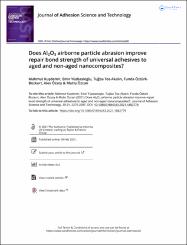| dc.contributor.author | Kuşdemir, Mahmut | |
| dc.contributor.author | Yüzbaşıoğlu, Emir | |
| dc.contributor.author | Toz Akalın, Tuğba | |
| dc.contributor.author | Öztürk Bozkurt, Funda | |
| dc.contributor.author | Özsoy, Alev | |
| dc.contributor.author | Özcan, Mutlu | |
| dc.date.accessioned | 2021-12-22T08:54:45Z | |
| dc.date.available | 2021-12-22T08:54:45Z | |
| dc.date.issued | 2021 | en_US |
| dc.identifier.citation | Kuşdemir, M., Yüzbaşıoğlu, E., Toz Akalın, T., Öztürk Bozkurt, F., Özsoy, A. ve Özcan, M. (2021). Does Al2O3 airborne particle abrasion improve repair bond strength of universal adhesives to aged and non-aged nanocomposites? Journal of Adhesion Science and Technology, 35(21), 2275-2287. https://doi.org/10.1080/01694243.2021.1882779 | en_US |
| dc.identifier.issn | 0169-4243 | |
| dc.identifier.issn | 1568-5616 | |
| dc.identifier.uri | https://doi.org/10.1080/01694243.2021.1882779 | |
| dc.identifier.uri | https://hdl.handle.net/20.500.12511/8710 | |
| dc.description.abstract | This study investigated the effect of universal adhesives on the resin composite-composite adhesion for immediate and aged repair with and without air-borne particle abrasion. Composite resin specimens were fabricated by placing multiple increments of resin composite (Clearfil Majesty Posterior) into cylindrical cavities (diameter: 4 mm, height: 2 mm) and photo-polymerized. Specimens (N = 720) were randomly assigned to 4 groups (fresh dry specimens, 24 h and 6 months water storage and thermocycled). These four main groups (n = 180) were further assigned to 2 groups (n = 90) according to the surface conditioning procedures; (a) Al2O3 air-abrasion and (b) No air-abrasion. Then, all subgroups were divided into six subgroups due to the adhesive procedures (a) All Bond Universal: AB (Bisco Inc.), (b) Monobond Plus: MP (Ivoclar Vivadent), (c) G-Premio Bond: GP (GC), Gluma Bond Universal: GB (Heraus Kulzer), Clearfil Universal Bond: CU (Kuraray), Clearfil Universal Bond Quick: SK (Kuraray). All bonding systems were applied according to the manufacturer's instructions and new composite blocks were bonded to the specimens for shear bond strength testing at the Universal Testing Machine (0.5 mm/min). Al2O3 air-abraded groups showed significantly higher bond strength values compared to non-treated groups (p < 0.0001). CU and SK groups showed higher bond strength values and the worst values were observed for the groups of MP. Conditioning with Al2O3 air-abrasion and silane in universal adhesives improves the bond strength of universal adhesives in composite repair. | en_US |
| dc.language.iso | eng | en_US |
| dc.publisher | Taylor and Francis Ltd. | en_US |
| dc.rights | info:eu-repo/semantics/openAccess | en_US |
| dc.rights | Attribution-NonCommercial-NoDerivatives 4.0 International | * |
| dc.rights.uri | https://creativecommons.org/licenses/by-nc-nd/4.0/ | * |
| dc.subject | Adhesion | en_US |
| dc.subject | Aging | en_US |
| dc.subject | Air-Abrasion | en_US |
| dc.subject | Bond Strength | en_US |
| dc.subject | Silane | en_US |
| dc.subject | Universal Adhesives | en_US |
| dc.title | Does Al2O3 airborne particle abrasion improve repair bond strength of universal adhesives to aged and non-aged nanocomposites? | en_US |
| dc.type | article | en_US |
| dc.relation.ispartof | Journal of Adhesion Science and Technology | en_US |
| dc.department | İstanbul Medipol Üniversitesi, Diş Hekimliği Fakültesi, Restoratif Diş Tedavisi Ana Bilim Dalı | en_US |
| dc.authorid | 0000-0001-9589-3232 | en_US |
| dc.identifier.volume | 35 | en_US |
| dc.identifier.issue | 21 | en_US |
| dc.identifier.startpage | 2275 | en_US |
| dc.identifier.endpage | 2287 | en_US |
| dc.relation.publicationcategory | Makale - Uluslararası Hakemli Dergi - Kurum Öğretim Elemanı | en_US |
| dc.identifier.doi | 10.1080/01694243.2021.1882779 | en_US |
| dc.identifier.wosquality | Q3 | en_US |
| dc.identifier.scopusquality | Q2 | en_US |



















